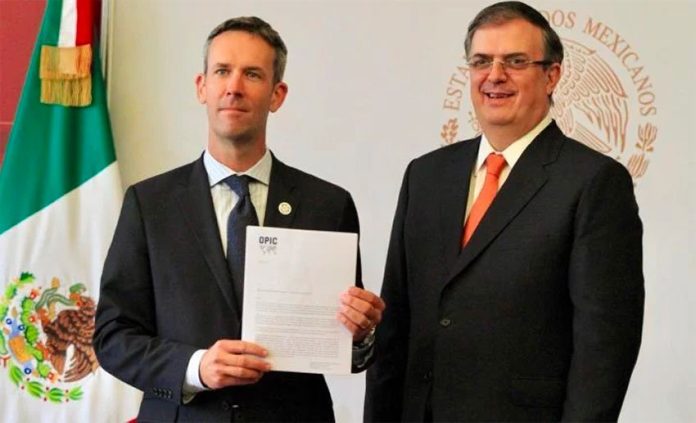The United States government committed yesterday to mobilizing public and private investment of more than US $500 million in southern Mexico to create jobs and stimulate development.
Ryan Brennan, chief operating officer at the Overseas Private Investment Corporation (OPIC) – the United States government’s development finance institution – and Foreign Affairs Secretary Marcelo Ebrard signed two letters of intent in which the U.S. pledged to procure the majority of the funding.
The commitment stems from an agreement the two countries reached in December to work together on a development plan in southern Mexico and Central America to curb migration.
In the first letter, OPIC committed to providing US $250 million for the construction of a natural gas liquefaction plant in Salina Cruz, Oaxaca.
The United States’ contribution will lead to additional investment of US $150 million for the plant, the Secretariat of Foreign Affairs (SRE) said in a statement.
In the second letter, OPIC pledged to provide a US $240-million loan for the construction of a wind power plant in southern Mexico. That amount will trigger additional investment of US $80 million, the SRE said.
In addition, OPIC said it will work with local banks and microfinance institutions to provide US $52 million in loans for micro, small and medium-sized companies in southern Mexico.
“This money will mobilize an additional investment of US $28 million, which will create jobs and boost prosperity in southern Mexico. This total of $80 million will be invested using a gender approach. Priority will be given to financing projects led by women,” the SRE said.
Brennan said he expected that the funding will be granted soon, adding that “these projects will create new economic opportunities in southern Mexico that empower individuals and lift communities.”
Ebrard said it was clear that the United States government is serious about its commitment to invest in development in the region.
“A lot of people said that this [the regional development plan] wasn’t going to work, that there would be no investment or it would take years . . . This demonstrates that the relationship with the United States, which is very complex, is a good one, and that good agreements make good sense,” he said.
The SRE said that in total, the OPIC commitments would lead to investment of US $800 million in the south of Mexico, “whose development is a government priority.”
The department also said that officials presented “a broad portfolio of investment projects” to OPIC and 12 are being evaluated for financing totaling a combined US $2.5 billion.
As part of the bilateral agreement signed in December, the United States committed to investing US $10.6 billion in development projects in southern Mexico and the Northern Triangle countries of Central America (Honduras, El Salvador, Guatemala) over a five-year period, although more than half of that funding will be allocated from existing aid programs.
When the funding was announced, the Washington Post reported that “it appears the only new figure is the $4.5 billion in potential loans, loan guarantees and related services through OPIC.”
In a post on his personal website under the title “This isn’t an aid package,” Adam Isacson, director for defense oversight at the Washington Office on Latin America, wrote that the only new U.S. money “is loans, not aid,” adding “it all has to be paid back.”
He also asserted that “they’re loans to the private sector, which are not going to address root causes of mass migration from Central America. They won’t reform police, fight corruption, fix justice systems, or anything else that makes threatened people safer from gangs.”
Still, the federal government has welcomed the United States’ commitment.
According to a joint statement issued on December 18, Mexico will receive US $4.8 billion from its northern neighbor over the next five years, while in the same period Mexico will invest US $25 billion in southern states.
President López Obrador argues that the best way to combat migration is to invest in development and job creation in regions where poverty and a lack of jobs force people to seek opportunities elsewhere, especially the United States.
The government announced in June that it will provide US $30 million for a reforestation program in El Salvador and this month said that a similar plan will also go ahead in Honduras.
While directing resources to development, the government also committed to step up enforcement against undocumented migrants as part of an agreement reached with the United States on June 7 that ended President Donald Trump’s threat to impose blanket tariffs on Mexican imports.
Statistics show that the measures being implemented by Mexico are effective.
Trump has praised Mexico’s efforts on several occasions since it ramped up immigration enforcement, and tweeted today that the country is “doing great at the border.”
Source: El Economista (sp)
